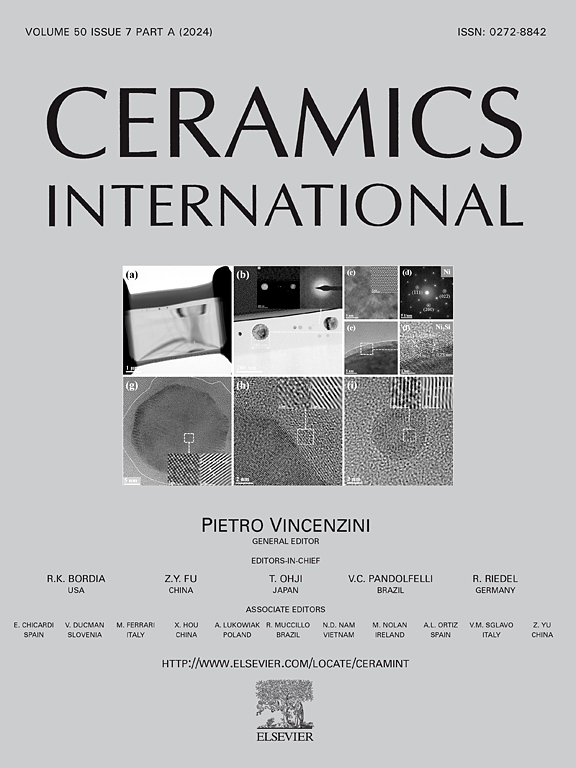Microstructure and magnetic properties of Fe-Al2O3 nanocomposites prepared by a versatile facile combustion-based route
IF 5.1
2区 材料科学
Q1 MATERIALS SCIENCE, CERAMICS
引用次数: 0
Abstract
Fe-Al2O3 nanocomposites with Al2O3 nanoparticles uniformly dispersed have been successfully prepared via a versatile facile and scalable combustion-based route with two steps. Firstly, the homogenous mixed oxide precursor composed with α-Fe2O3, γ-Fe2O3 and Al2O3 was prepared by solution combustion synthesis. Subsequently, Fe-Al2O3 nanocomposites with Al2O3 nanoparticles evenly dispersed were prepared by hydrogen reduction of the mixed oxide precursor. The effects of the various reduction temperatures on the phase composition, morphology, grain size and magnetic properties of the Fe-Al2O3 nanocomposites were investigated in details. The results show that the Fe-Al2O3 nanocomposites prepared at as low as 400 °C present a connected network structure with an average grain size of about 17 nm, which have a saturation magnetization of 125.3 emu/g, and a coercivity of 721.2 Oe. With the increase of reduction temperature, the average grain size, and saturation magnetization of the Fe-Al2O3 nanocomposites increase gradually, while the coercivity decrease. When the reduction temperature is increased to 500 °C and 600 °C, the grain size increases to about 27 nm and 37 nm, the saturation magnetization increases to 153.6 emu/g and 177.1 emu/g, and the coercivity decreases to 634.6 Oe and 467.8 Oe, respectively.
求助全文
约1分钟内获得全文
求助全文
来源期刊

Ceramics International
工程技术-材料科学:硅酸盐
CiteScore
9.40
自引率
15.40%
发文量
4558
审稿时长
25 days
期刊介绍:
Ceramics International covers the science of advanced ceramic materials. The journal encourages contributions that demonstrate how an understanding of the basic chemical and physical phenomena may direct materials design and stimulate ideas for new or improved processing techniques, in order to obtain materials with desired structural features and properties.
Ceramics International covers oxide and non-oxide ceramics, functional glasses, glass ceramics, amorphous inorganic non-metallic materials (and their combinations with metal and organic materials), in the form of particulates, dense or porous bodies, thin/thick films and laminated, graded and composite structures. Process related topics such as ceramic-ceramic joints or joining ceramics with dissimilar materials, as well as surface finishing and conditioning are also covered. Besides traditional processing techniques, manufacturing routes of interest include innovative procedures benefiting from externally applied stresses, electromagnetic fields and energetic beams, as well as top-down and self-assembly nanotechnology approaches. In addition, the journal welcomes submissions on bio-inspired and bio-enabled materials designs, experimentally validated multi scale modelling and simulation for materials design, and the use of the most advanced chemical and physical characterization techniques of structure, properties and behaviour.
Technologically relevant low-dimensional systems are a particular focus of Ceramics International. These include 0, 1 and 2-D nanomaterials (also covering CNTs, graphene and related materials, and diamond-like carbons), their nanocomposites, as well as nano-hybrids and hierarchical multifunctional nanostructures that might integrate molecular, biological and electronic components.
 求助内容:
求助内容: 应助结果提醒方式:
应助结果提醒方式:


